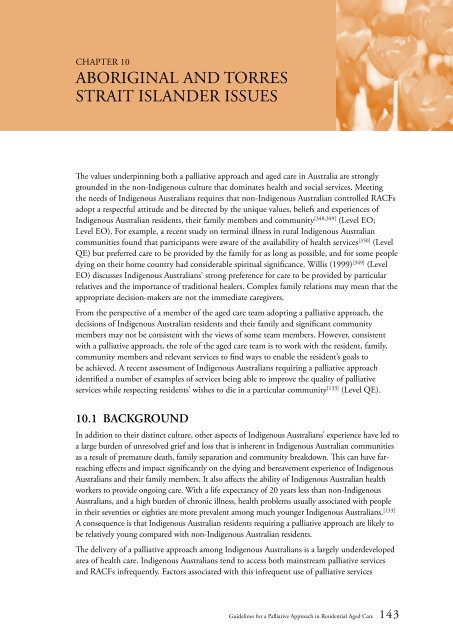Guidelines for a Palliative Approach in Residential Aged Care
Guidelines for a Palliative Approach in Residential Aged Care
Guidelines for a Palliative Approach in Residential Aged Care
You also want an ePaper? Increase the reach of your titles
YUMPU automatically turns print PDFs into web optimized ePapers that Google loves.
CHAPTER 10<br />
ABORIGINAL AND TORRES<br />
STRAIT ISLANDER ISSUES<br />
The values underp<strong>in</strong>n<strong>in</strong>g both a palliative approach and aged care <strong>in</strong> Australia are strongly<br />
grounded <strong>in</strong> the non-Indigenous culture that dom<strong>in</strong>ates health and social services. Meet<strong>in</strong>g<br />
the needs of Indigenous Australians requires that non-Indigenous Australian controlled RACFs<br />
adopt a respectful attitude and be directed by the unique values, beliefs and experiences of<br />
Indigenous Australian residents, their family members and community [348,349] (Level EO;<br />
Level EO). For example, a recent study on term<strong>in</strong>al illness <strong>in</strong> rural Indigenous Australian<br />
communities found that participants were aware of the availability of health services [350] (Level<br />
QE) but preferred care to be provided by the family <strong>for</strong> as long as possible, and <strong>for</strong> some people<br />
dy<strong>in</strong>g on their home country had considerable spiritual significance. Willis (1999) [349] (Level<br />
EO) discusses Indigenous Australians’ strong preference <strong>for</strong> care to be provided by particular<br />
relatives and the importance of traditional healers. Complex family relations may mean that the<br />
appropriate decision-makers are not the immediate caregivers.<br />
From the perspective of a member of the aged care team adopt<strong>in</strong>g a palliative approach, the<br />
decisions of Indigenous Australian residents and their family and significant community<br />
members may not be consistent with the views of some team members. However, consistent<br />
with a palliative approach, the role of the aged care team is to work with the resident, family,<br />
community members and relevant services to f<strong>in</strong>d ways to enable the resident’s goals to<br />
be achieved. A recent assessment of Indigenous Australians requir<strong>in</strong>g a palliative approach<br />
identified a number of examples of services be<strong>in</strong>g able to improve the quality of palliative<br />
services while respect<strong>in</strong>g residents’ wishes to die <strong>in</strong> a particular community [133] (Level QE).<br />
10.1 BACKGROUND<br />
In addition to their dist<strong>in</strong>ct culture, other aspects of Indigenous Australians’ experience have led to<br />
a large burden of unresolved grief and loss that is <strong>in</strong>herent <strong>in</strong> Indigenous Australian communities<br />
as a result of premature death, family separation and community breakdown. This can have farreach<strong>in</strong>g<br />
effects and impact significantly on the dy<strong>in</strong>g and bereavement experience of Indigenous<br />
Australians and their family members. It also affects the ability of Indigenous Australian health<br />
workers to provide ongo<strong>in</strong>g care. With a life expectancy of 20 years less than non-Indigenous<br />
Australians, and a high burden of chronic illness, health problems usually associated with people<br />
<strong>in</strong> their seventies or eighties are more prevalent among much younger Indigenous Australians. [133]<br />
A consequence is that Indigenous Australian residents requir<strong>in</strong>g a palliative approach are likely to<br />
be relatively young compared with non-Indigenous Australian residents.<br />
The delivery of a palliative approach among Indigenous Australians is a largely underdeveloped<br />
area of health care. Indigenous Australians tend to access both ma<strong>in</strong>stream palliative services<br />
and RACFs <strong>in</strong>frequently. Factors associated with this <strong>in</strong>frequent use of palliative services<br />
<strong>Guidel<strong>in</strong>es</strong> <strong>for</strong> a <strong>Palliative</strong> <strong>Approach</strong> <strong>in</strong> <strong>Residential</strong> <strong>Aged</strong> <strong>Care</strong> 143
















